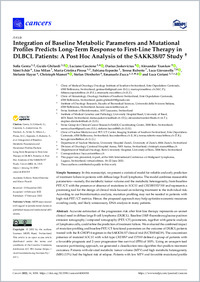Integration of baseline metabolic parameters and mutational profiles predicts long-term response to first-line therapy in DLBCL patients : a post hoc analysis of the SAKK38/07 study
- Genta, Sofia Clinic of Medical Oncology, Oncology Institute of Southern Switzerland (IOSI), Bellinzona, Switzerland
- Ghilardi, Guido ORCID Clinic of Hematology, Oncology Institute of Southern Switzerland (IOSI), Bellinzona, Switzerland
- Cascione, Luciano ORCID Institute of Oncology Research (IOR), Faculty of Biomedical Sciences, Università della Svizzera italiana, Switzerland ; Swiss Institute of Bioinformatics, Lausanne, Switzerland
- Juskevicius, Darius ORCID Institute of Medical Genetics and Pathology, University Hospital Basel, University of Basel, Basel, Switzerland
- Tzankov, Alexandar ORCID Institute of Medical Genetics and Pathology, University Hospital Basel, University of Basel, Basel, Switzerland
- Schär, Sämi Swiss Group for Clinical Cancer Research (SAKK) Coordinating Center, Bern, Switzerland
- Milan, Lisa Clinic of Nuclear Medicine and PET/CT Center, Imaging Institute of Southern Switzerland, Ente Ospedaliero Cantonale, Bellinzona, Switzerland
- Pirosa, Maria Cristina Clinic of Medical Oncology, Oncology Institute of Southern Switzerland (IOSI), Bellinzona, Switzerland ; Clinic of Hematology, Oncology Institute of Southern Switzerland (IOSI), Bellinzona, Switzerland
- Esposito, Fabiana Clinic of Medical Oncology, Oncology Institute of Southern Switzerland (IOSI), Bellinzona, Switzerland
- Ruberto, Teresa Clinic of Nuclear Medicine and PET/CT Center, Imaging Institute of Southern Switzerland, Ente Ospedaliero Cantonale, Bellinzona, Switzerland
- Giovanella, Luca ORCID Clinic of Nuclear Medicine and PET/CT Center, Imaging Institute of Southern Switzerland, Ente Ospedaliero Cantonale, Bellinzona, Switzerland ; Department of Nuclear Medicine, University Hospital Zurich, University of Zurich, Zurich, Switzerland
- Hayoz, Stefanie Swiss Group for Clinical Cancer Research (SAKK) Coordinating Center, Bern, Switzerland
- Mamot, Christoph ORCID Division of Oncology, Cantonal Hospital Aarau, Aarau, Switzerland
- Dirnhofer, Stefan Institute of Medical Genetics and Pathology, University Hospital Basel, University of Basel, Basel, Switzerland
- Zucca, Emanuele ORCID Clinic of Medical Oncology, Oncology Institute of Southern Switzerland (IOSI), Bellinzona, Switzerland ; Institute of Oncology Research (IOR), Faculty of Biomedical Sciences, Università della Svizzera italiana, Switzerland ; Department of Medical Oncology, Bern University Hospital, University of Bern, Bern, Switzerland
- Ceriani, Luca ORCID Institute of Oncology Research (IOR), Faculty of Biomedical Sciences, Università della Svizzera italiana, Switzerland ; Clinic of Nuclear Medicine and PET/CT Center, Imaging Institute of Southern Switzerland, Ente Ospedaliero Cantonale, Bellinzona, Switzerland
- 2022
Published in:
- Cancers. - 2022, vol. 14, p. 1018
English
Accurate estimation of the progression risk after first-line therapy represents an unmet clinical need in diffuse large B-cell lymphoma (DLBCL). Baseline (18)F-fluorodeoxyglucose positron emission tomography/computed tomography (PET/CT) parameters, together with genetic analysis of lymphoma cells, could refine the prediction of treatment failure. We evaluated the combined impact of mutation profiling and baseline PET/CT functional parameters on the outcome of DLBCL patients treated with the R-CHOP14 regimen in the SAKK38/07 clinical trial (NCT00544219). The concomitant presence of mutated SOCS1 with wild-type CREBBP and EP300 defined a group of patients with a favorable prognosis and 2-year progression-free survival (PFS) of 100%. Using an unsupervised recursive partitioning approach, we generated a classification-tree algorithm that predicts treatment outcomes. Patients with elevated metabolic tumor volume (MTV) and high metabolic heterogeneity (MH) (15%) had the highest risk of relapse. Patients with low MTV and favorable mutational profile (9%) had the lowest risk, while the remaining patients constituted the intermediate-risk group (76%). The resulting model stratified patients among three groups with 2-year PFS of 100%, 82%, and 42%, respectively (p < 0.001).
- Collections
- Language
-
- English
- Classification
- Medicine
- License
- Open access status
- gold
- Identifiers
-
- DOI 10.3390/cancers14041018
- ARK ark:/12658/srd1326726
- Persistent URL
- https://n2t.net/ark:/12658/srd1326726
Statistics
Document views: 102
File downloads:
- Ceriani_2022_MDPI_cancers: 210
